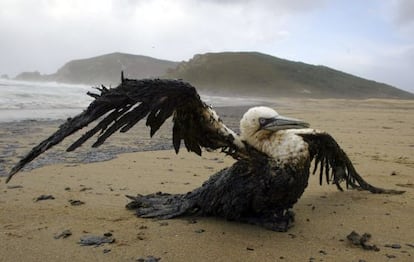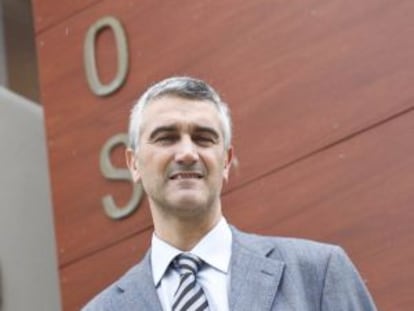Ten years on, environmental disaster finally reaches A Coruña courthouse
Captain of stricken tanker faces prison sentence for environmental negligence Naval engineer claims vital evidence has been omitted from trial

Nine years of pre-trial investigation are reflected in 230,315 pages, 25 boxes filled with evidence and 1,500 plaintiffs (originally more than 2,000) grouped into 55 separate accusations.
The trial will feature 70 lawyers and 140 witnesses. With figures like these, it seems impossible that any relevant detail might be missing from the massive report on the Prestige oil spill of November 2002, the worst environmental disaster ever seen on the Spanish peninsula.
But shortly before the start of the Prestige trial in A Coruña on October 16, an expert said that there is indeed something missing: an analysis commissioned by the defense lawyer for the ship's captain, Apostolos Mangouras, and signed by the naval engineer Carlos Delgado Macías, claims that there were measurements made immediately after the ship sank that were never included in the official report now in the court's power.
Delgado Macías and others analyzed tens of thousands of photographs
Delgado Macías and others analyzed tens of thousands of photographs and hundreds of hours of audio and video recordings of the complex and expensive inspections carried out on the hull of the Prestige, in the depths of the Bay of Biscay, between December 2002 and May 2003, and also between August and October 2003.
After doing so, he discovered that the findings were not included in the summary proceedings. Yet he says they are vital to determine whether the old single-hull vessel, launched in 1976, was already a toxic bomb on the verge of exploding during its last journey - as claimed by the attorney general representing the state's interests in the trial - or whether it was just a stroke of ill fortune that caused one of Europe's largest black tides, some 60,000 metric tons of fuel oil that contaminated 1,600 kilometers of coastline - from the mouth of the Miño between Galicia and Portugal to the French Atlantic coast.
This expert report, which was sent to the Provincial Court of A Coruña last July, has not been accepted as evidence yet. But it holds that the Spanish technicians who reviewed the shipwreck following orders from the government of José María Aznar, of the Popular Party (PP), measured the size and the thickness of structural elements of the ship. Their findings would clear up whether the latest repairs that the Prestige underwent at a Chinese shipyard were correct or not, and whether corrosion of the hull was as intense as the accusation claims. Apostolos Mangouras, the Greek captain who has been largely blamed for the environmental catastrophe, faces a 12-year prison term if found guilty.
Government technicians "made no reference" to their 2003 findings
"Those documents, images and videos make it manifestly clear that the technicians carried out measurements of the dimensions and the thickness of the various structural elements of the ship, the results of which have nevertheless not been added to the criminal proceedings underway," reads the report by Delgado Macías.
In order to find evidence of these measurements, the engineer reviewed all existing videos, audio recordings and photographs of the inspections, but he says he could not get started on this job until 2010, when the small courthouse of Corcubión that conducted the investigation finished digitalizing the material and sent it to him.
Delgado Macías said it was "incomprehensible" that the government technicians "made no reference whatsoever" to their 2003 findings, "considering those are physical, definitive and incontestable pieces of evidence regarding the real state of the oil tanker's structure."
The expert report, sent to A Coruña, has not been accepted as evidence yet
The Nautile, a submarine used by a French company working for the Public Works Ministry to find out whether there were further fuel leaks after the Prestige sank, used its articulated arm to measure the thickness and length of the ship's longitudinal reinforcement number 31, located level with rib 64 in the side tank number 3, on the port side; this element was fitted at a Chinese shipyard the last time that the Prestige went in for repairs.
The accusation against the captain claims that this reinforcement did not have the proper dimensions to guarantee the safety of the journey, and that as a result, the accident that occurred 50 kilometers from Finisterre ended up destroying the tanker's structure. Yet the measurements of this piece were not sent to the courthouse.
A court in Brest, France, did find out about it, though. At the time, the judge there was carrying out his own investigation into the accident, and he incorporated the records of that underwater work; sources familiar with the case say that it was, in fact, thanks to this neighboring court that the records got to Corcubión in the first place, since both investigations merged into one in 2007. During the second inspection of the hull, in 2003, technicians also noted the width of the reinforcements put in by the Chinese shipyard, as well as corrosion levels in the hull's plating and inner bulkheads, as Delgado Macías and his colleagues discovered. This time it was the remote-controlled submarines Innovador 2 and Innovador 5, rented out by Spain through the energy company Repsol, which carried out the measurements. The latter were not mentioned by the Spanish technicians on the expedition, either.
Spain sued the American Bureau of Shipping at a parallel trial in New York
But somebody else did point it out: at a parallel trial in New York, where the Spanish state was suing the American Bureau of Shipping for certifying the Prestige as safe, a Spanish technician who was aboard the Polar Prince, a ship that came near the Prestige wreck, testified that the ship measurements that are absent from the major trial starting this week do, in fact, exist.
This is not the only information to come to light in the New York lawsuit (which Spain lost) that will be absent from the Spanish trial. The US judge ordered an analysis of the disks that Repsol cut out of the Prestige's deck in 2004 to extract the remaining fuel in the tanks. These pieces could help determine the state of conservation of the hull and clear up the overall state of the ship. This information was also left out of the penal proceedings in Spain, even though Captain Mangouras' defense requested to add it to the summary. The Spanish state asked the Corcubión courthouse to get rid of the disks because they lacked "evidential value."
Government, officers and officials in the dock over 2002 catastrophe

Tuesday marked the beginning of the trial over the sinking of the Prestige, an oil tanker that went down near Galicia's Costa da Morte on November 19, 2002 with 77,000 tons of fuel oil in its hold. A decade later, nature and an extremely expensive cleanup - including the emptying out of the sunken wreck, located 3,600 meters under the sea and 246 kilometers from the mainland - have worked together to eliminate the impact of the tar that once covered fauna and flora in the area.
The Provincial Court of A Coruña, whose members have temporarily moved to the city's convention center because of the sheer size of the trial, will decide whether it accepts new evidence in the case and adjourn until November 13, when the main defendant will be interrogated. Apostolos Mangouras was the Greek captain of a ship flying a Bahamas flag, owned by a Liberian company (Mare Shipping), covered by a British insurer (The London Steamship Owners Insurance), certified by the American Bureau of Shipping and chartered by the Swiss cargo company Crown Resources.
It is quite a conglomerate of countries, interests and plaintiffs, including the Spanish and the French states, which partly explains why it took so long for the trial to begin.
The hearing, which will last another seven months, will not only determine who is to blame for the Prestige disaster. Also on the line is the prestige of the justice system itself after the nine years it took the small courthouse in Corcubión to complete an investigation that was as erratic as the path of the oil tanker during the six days it swayed to and fro before breaking up and sinking.
The way the government handled the disaster is another key issue in this trial. Then, as now, Spain was in the hands of the center-right Popular Party (PP) with José María Aznar at the helm and his right-hand man Mariano Rajoy (now the prime minister) heading the damage-control operation.
The Spanish state is at once a plaintiff and a defendant in the case. As the former, it is asking for the highest damages: 3.86 billion euros out of the 4.12 billion the attorney general calculates is the cost of the tragedy. But the state could also be found vicariously liable and made to pay part of the amount.
The main defendants in the case are Captain Mangouras, his engineer officer (a third ship officer fled and his whereabouts are not known) and the former director of the Merchant Marine, José Luis López-Sors. His presence in the dock is one of the latest surprises in a long and tortuous investigation conducted by five separate judges.
The last judge to deal with the investigation laid the blame squarely on the captain and two other ship officers, and found that the Aznar government had no responsibility in the case. This judge had no problem accepting as a key expert in the investigation an engineer who had worked as a consultant to the Public Works Ministry during the shipwreck. She also considered, as did the attorney general, that the disaster was unavoidable even before the government took charge of the problem and decided to steer the ship away from the coast despite the storm and the burst tank that was already spilling out thousands of tons of fuel.
But the Provincial Court has revoked this acquittal and included López-Sors, now retired, on the list of defendants. At the time, the former Merchant Marine director answered to Public Works Minister Francisco Álvarez-Cascos, and as such he took full responsibility for the Prestige's final journey. The court will determine whether the government's actions played a role in the dimensions of the catastrophe. A ruling is expected by September 2013.
Tu suscripción se está usando en otro dispositivo
¿Quieres añadir otro usuario a tu suscripción?
Si continúas leyendo en este dispositivo, no se podrá leer en el otro.
FlechaTu suscripción se está usando en otro dispositivo y solo puedes acceder a EL PAÍS desde un dispositivo a la vez.
Si quieres compartir tu cuenta, cambia tu suscripción a la modalidad Premium, así podrás añadir otro usuario. Cada uno accederá con su propia cuenta de email, lo que os permitirá personalizar vuestra experiencia en EL PAÍS.
¿Tienes una suscripción de empresa? Accede aquí para contratar más cuentas.
En el caso de no saber quién está usando tu cuenta, te recomendamos cambiar tu contraseña aquí.
Si decides continuar compartiendo tu cuenta, este mensaje se mostrará en tu dispositivo y en el de la otra persona que está usando tu cuenta de forma indefinida, afectando a tu experiencia de lectura. Puedes consultar aquí los términos y condiciones de la suscripción digital.
More information
Últimas noticias
From Andorra to Gibraltar, a black market for Ozempic exploits its success: ‘They’re the most sought-after products in the world’
Magnets in their heads: How some animals guide themselves using the Earth’s magnetic field
From Hungary’s Orbán to Chile’s Kast: How Trump helps turbo charge the far right
The brief rise and retreat of Generation Z in Mexico
Most viewed
- Why we lost the habit of sleeping in two segments and how that changed our sense of time
- Trump’s obsession with putting his name on everything is unprecedented in the United States
- Charles Dubouloz, mountaineering star, retires at 36 with a farewell tour inspired by Walter Bonatti
- Venezuela faces its most tense Christmas yet
- The Florida Keys tourist paradise is besieged by immigration agents: ‘We’ve never seen anything like this’










































